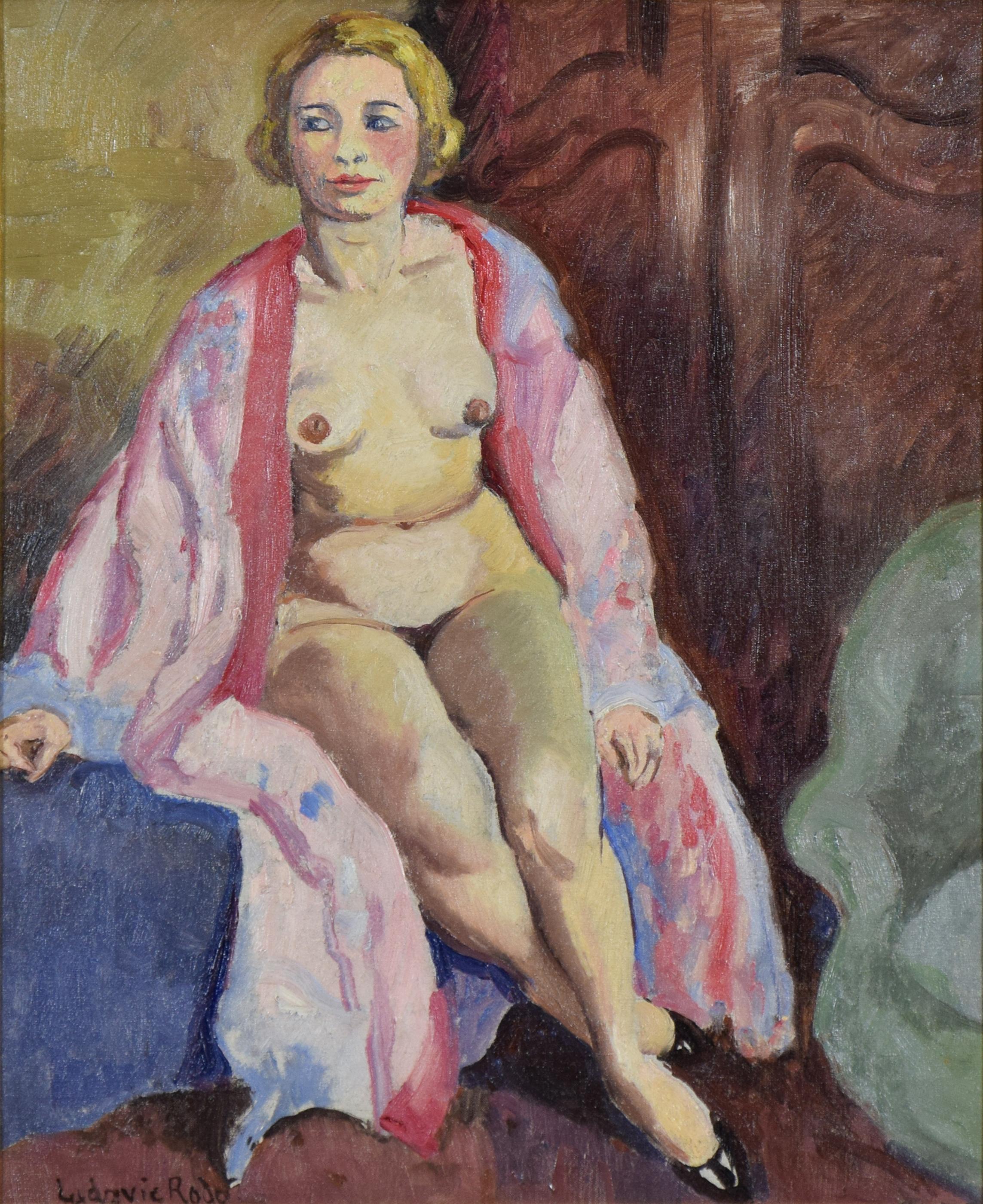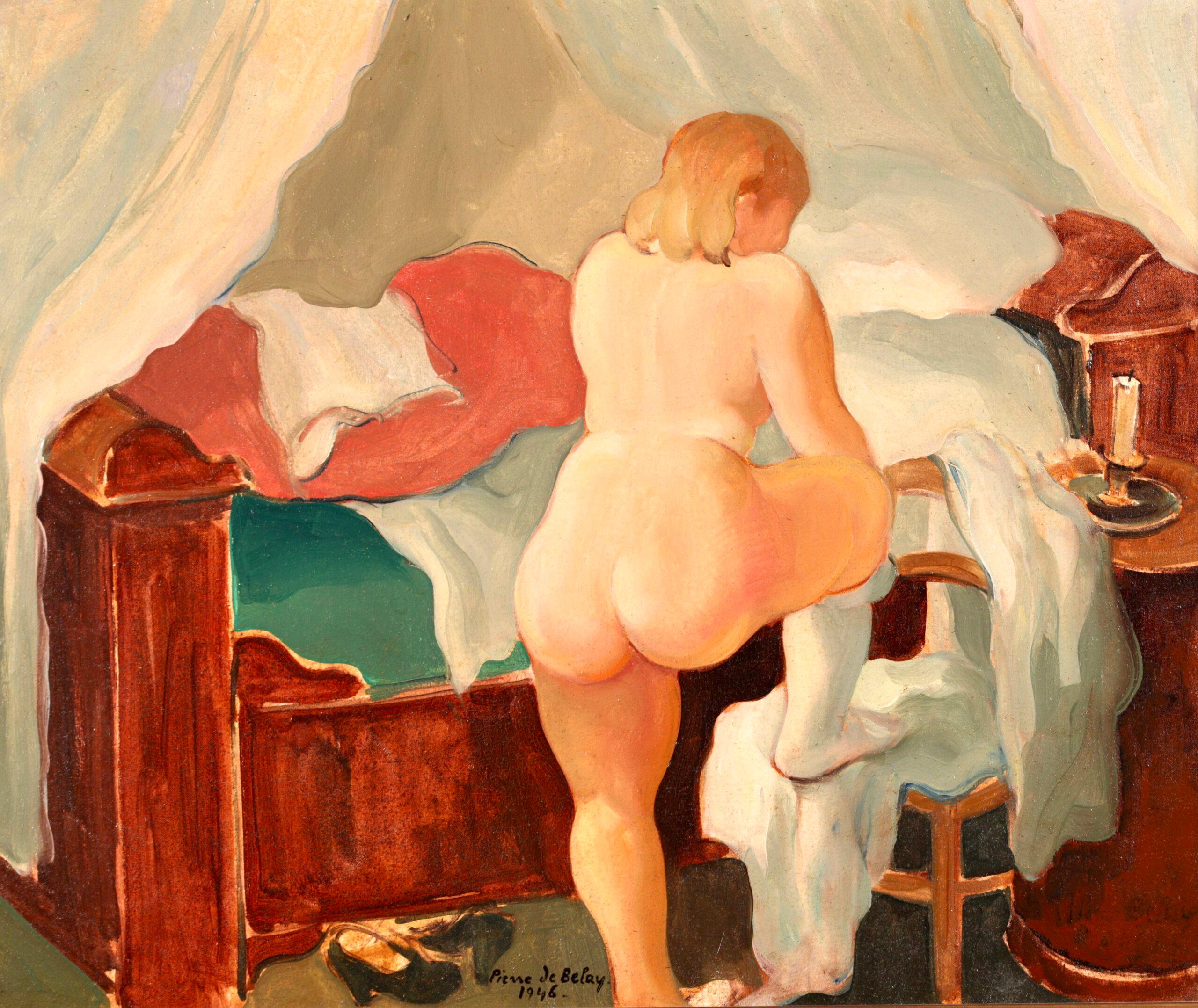Ludovic-Rodo PissarroNu au canapé bleu y Ludovic-Rodo Pissarro - Nude paintingcirca 1910
circa 1910
About the Item
- Creator:Ludovic-Rodo Pissarro (1878 - 1952, French)
- Creation Year:circa 1910
- Dimensions:Height: 18.12 in (46 cm)Width: 14.97 in (38 cm)
- Medium:
- Movement & Style:
- Period:
- Condition:
- Gallery Location:London, GB
- Reference Number:1stDibs: LU261211637732
Ludovic-Rodo Pissarro
Ludovic-Rodolphe Pissarro, born in Paris in 1878, was influential French Impressionist painter Camille Pissarro’s fourth son. Encouraged by his father, he began drawing from nature at an early age. He was familiarly known as “Rodo” and generally signed his works "Ludovic-Rodo,” or early on in his career, "Rodo.”
The impact of Camille’s art and teaching on Rodo was considerable, and his artistic production encompassed a wide range of media, including oil painting, tempera, watercolour, gouache, wood engraving, drawing and lithography. Rodo exhibited regularly at the Salon des Indépendents over a 40-year period.
In 1894, at the age of 16, Rodo published his first wood engravings in the anarchist journal, Le Père Peinard. When Camille left France for the safety of Belgium during the anarchist upheavals of the same year, Rodo joined him there.
Rodo moved into his first studio in Montmartre with his brother Georges in 1898. He found the nightlife of Paris and the habitués of the cafes, theatres, circuses and cabarets of the area compelling subjects for his work. With his younger brother, Paulémile, Rodo met artists such as Kees van Dongen, Maurice de Vlaminck and Raoul Dufy. In 1905, he participated in the first Fauve exhibition at the Salon des Indépendants.
At the outbreak of the War in 1914, Rodo moved to England. Over the next few years, he lived mainly in and around West London. He worked closely with his brother, Lucien, to establish, in 1915, the Monarro Group, formed with the aim of exhibiting work by contemporary artists inspired by Impressionism. Many of the works, produced by Rodo while he was in England, were of major London landmarks. After 1924, when Rodo had already returned to France, he divided his time between Paris and Les Andelys in Normandy. Despite his rich artistic heritage and his achievements as an artist, Rodo is perhaps best remembered for his contribution to art history. For 20 years, he researched and compiled a catalogue of his father’s paintings – a project that was finally published in two volumes in 1939 — and is still considered to be the definitive reference book on Camille’s work. Rodo told Lucien that the compilation of this catalogue was a fascinating task, revealing as it did “the work of the artist, its highs and lows, its progress, as a whole, through acquired experience.”
(Biography provided by Stern Pissarro Gallery)
- ShippingRetrieving quote...Ships From: London, United Kingdom
- Return PolicyA return for this item may be initiated within 7 days of delivery.
- Deux Baigneuses dans un Paysage by GEORGES MANZANA PISSARRO - BathersBy Georges Henri Manzana PissarroLocated in London, GBDeux Baigneuses dans un Paysage by GEORGES MANZANA PISSARRO (1871-1961) Oil on canvas 38 x 46 cm (15 x 18 1⁄8 inches) Signed and dated lower left, Manzana Pissarro 55 This work is ...Category
1950s Post-Impressionist Figurative Paintings
MaterialsCanvas, Oil
- Nu Assise by Ludovic-Rodo Pissarro - Nude paintingBy Ludovic-Rodo PissarroLocated in London, GBNu Assise by Ludovic-Rodo Pissarro (1878-1952) Oil on canvas 55 x 47 cm (21 ⅝ x 18 ½ inches) Signed lower left, Ludovic Rodo Executed circa 1910 This work is accompanied by a cer...Category
1910s Fauvist Nude Paintings
MaterialsCanvas, Oil
- Nude oil painting by Ludovic Rodo Pissarro titled 'La Brune au Tableau de Nu'By Ludovic-Rodo PissarroLocated in London, GB'La Brune au Tableau de Nu' by Ludovic Rodo Pissarro Oil on canvas 60 x 81.5 cm (23 ⅝ x 32 ⅛ inches) Signed lower left, Ludovic Rodo Executed circa 1910 T...Category
Early 1900s Post-Impressionist Nude Paintings
MaterialsCanvas, Oil
- Cabaret Dancers by LUDOVIC-RODO PISSARRO - Post-Impressionist Art, Paris ScenesBy Ludovic-Rodo PissarroLocated in London, GBCabaret Dancers by LUDOVIC-RODO PISSARRO (1878-1952) Oil on panel 46 x 55 cm (18 ⅛ x 21 ⅝ inches) Signed lower left, Ludovic Rodo Painted circa 1906 A rare Fauve work from the art...Category
Early 20th Century Fauvist Figurative Paintings
MaterialsOil
- Baigneuses avec cygne by Georges Manzana Pissarro - Nude oil paintingBy Georges Henri Manzana PissarroLocated in London, GB*UK BUYERS WILL PAY AN ADDITIONAL 20% VAT ON TOP OF THE ABOVE PRICE Baigneuses avec cygne by Georges Manzana Pissarro (1871-1961) Oil on panel 30 x 37.5 cm (11 ³/₄ x 14 ³/₄ inches) ...Category
1930s Post-Impressionist Figurative Paintings
MaterialsPanel, Oil
- Baigneuses en Bord de Rivière by Georges Manzana Pissarro - Nude paintingBy Georges Henri Manzana PissarroLocated in London, GB*UK BUYERS WILL PAY AN ADDITIONAL 5% IMPORT DUTY ON TOP OF THE ABOVE PRICE Baigneuses en Bord de Rivière by Georges Manzana Pissarro (1871-1961) Oil on cardboard 98.2 x 79.4 cm (38...Category
1910s Post-Impressionist Figurative Paintings
MaterialsOil, Cardboard
- Le carnaval du sage by René MagritteBy René MagritteLocated in New Orleans, LARené Magritte 1898-1967 Belgian Le carnaval du sage (The Sage’s Carnival) Signed “Magritte” (lower right); titled and dated "Le carnaval du sage 1947" (en verso) Oil on canvas The enigmatic paintings of René Magritte have become some of the most familiar and celebrated of the Surrealist movement. Among the most influential of the Surrealist painters of the 20th century, Magritte is an artist of international renown, as beloved for his popular appeal as he is for the psychological intensity of his works. The present oil on canvas, entitled Le carnaval du sage, was executed in 1947 at the height of his career, and it is a tour-de-force example of the haunting, mysterious scenes that comprise his oeuvre. Painted in the years following the Second World War, Le carnaval du sage showcases several recurring themes from Magritte’s oeuvre. Chiefly, a juxtaposition between the visible and the hidden is keenly felt. Throughout his career, Magritte explores the psychological obsession with revealing what is hidden, particularly with regard to the human face. In his Le fils de l’homme, he obscures the face of a man in a bowler hat with an apple, while his Les amants (Metropolitan Museum of Art) conceals the faces of two lovers with white sheets. In Le carnaval du sage, Magritte juxtaposes the blatant nudity of his central figure by masking her face, simultaneously revealing and concealing her from the viewer. The work also incorporates two of Magritte’s most common tropes – the glass of water and the baguette. Lending the scene a strange sense of domesticity, they appear infinitely familiar and distinctly out of place, and thus heighten the uncanny effect of Magritte’s composition. In the background hovers a ghost obscured by a sheet, a figure which was of particular fascination to Magritte beginning in 1946. He once wrote to his fellow Surrealist Paul Nougé: "I saw in a dream an answer to the problem of the ghost: the traditional ghost draped...Category
20th Century Post-Impressionist Nude Paintings
MaterialsCanvas, Oil
- Le Coucher - Post Impressionist Nude in Interior Oil Painting by Pierre de BelayBy Pierre de BelayLocated in Marlow, BuckinghamshireSigned and dated nude figure in interior oil on canvas by French post impressionist painter Pierre De Belay. This work depicts a painting of Pierre De Belay's wife - Helene. Here she...Category
1940s Post-Impressionist Nude Paintings
MaterialsOil, Canvas
- Fragment 6 (dreamy woman back skin female figurative painting soft Earth tones)By Rudolf KosowLocated in Quebec, Quebec"Fragment" by Rudolf Kosow is a poignant miniature painting on wood, which masterfully captures the essence of contemporary portrait art with a nuanced approach. The painting feature...Category
2010s Post-Impressionist Figurative Paintings
MaterialsCanvas, Oil, Acrylic, Wood Panel
- Fragment 8 (dreamy woman back skin female figurative painting soft Earth tones)By Rudolf KosowLocated in Quebec, Quebec"Fragment 8" by Rudolf Kosow is an evocative miniature painting on wood, capturing the elusive nature of human memory and emotion through abstract forms and subtle colors. This artwo...Category
2010s Post-Impressionist Figurative Paintings
MaterialsOil, Canvas, Acrylic, Wood Panel
- Fragment 9 (dreamy woman back skin female figurative painting soft Earth tones)By Rudolf KosowLocated in Quebec, Quebec"Fragment 9" by Rudolf Kosow is a striking miniature painting that employs a minimalist yet impactful use of color and form to convey deep emotional and psychological states. The art...Category
2010s Post-Impressionist Figurative Paintings
MaterialsCanvas, Oil, Acrylic, Wood Panel
- Nu avec des fleurs - Post-Impressionist Oil, Nude & Flowers - Georges D'EspagnatBy Georges d'EspagnatLocated in Marlow, BuckinghamshireSigned nude oil on original canvas circa 1910 by French post impressionist painter Georges D'espagnat. The work depict a nude woman seated on a stall turned away from the artist. Paintings hang on the wall and there's a vase filled with pink and red flowers on the wooden mantlepiece beside her. Signature: Signed upper left Dimensions: Framed: 30"x26" Unframed: 22"x18" Provenance: Private French collection. Exhibition stamp verso From the beginning of his career, it was a constant concern of Georges d'Espagnet to assert his originality. His studies at the École des Arts Décoratifs, Paris, did not last very long, for he wanted immediate independence and decided to follow courses in the private academies of Montparnasse. In about 1900, he became acquainted with Maurice Denis, Bonnard and Vuillard, and his collaboration with Denis led to a renewal of religious art in France. In 1903, d'Espagnet was one of the founders of the Salon d'Automne, and was appointed professor in charge of studios at the École des Beaux-Arts, Paris, in 1934. He illustrated a number of books: Rémy de Gourmont's Evil Prayers ( Oraisons mauvaises) (1896), The Saints of Paradise ( Les Saintes du paradis) (1898), Simone (1907), Sistine ( Sixtine) (1922); Alphonse Daudet's The Immortal ( L'Immortel) (1930); André Gide's The Pastoral Symphony ( La Symphonie pastorale); Francis Jammes' Clearings in the Sky ( Chairières dans le ciel) (1948). D'Espagnet belongs to the group of artists who made the Courrier Français so successful. The drawings of his which are published in it are strongly expressive and some bear comparison with the designs of the great Renaissance masters. He also contributed to L'Image. He often placed cheerful nudes in a landscape, reminding us that, though he moved away from the Fauves, he retained their freedom of colour and arabesque. He painted many portraits, including those of Albert André, André Barbier...Category
1910s Post-Impressionist Nude Paintings
MaterialsOil, Canvas




